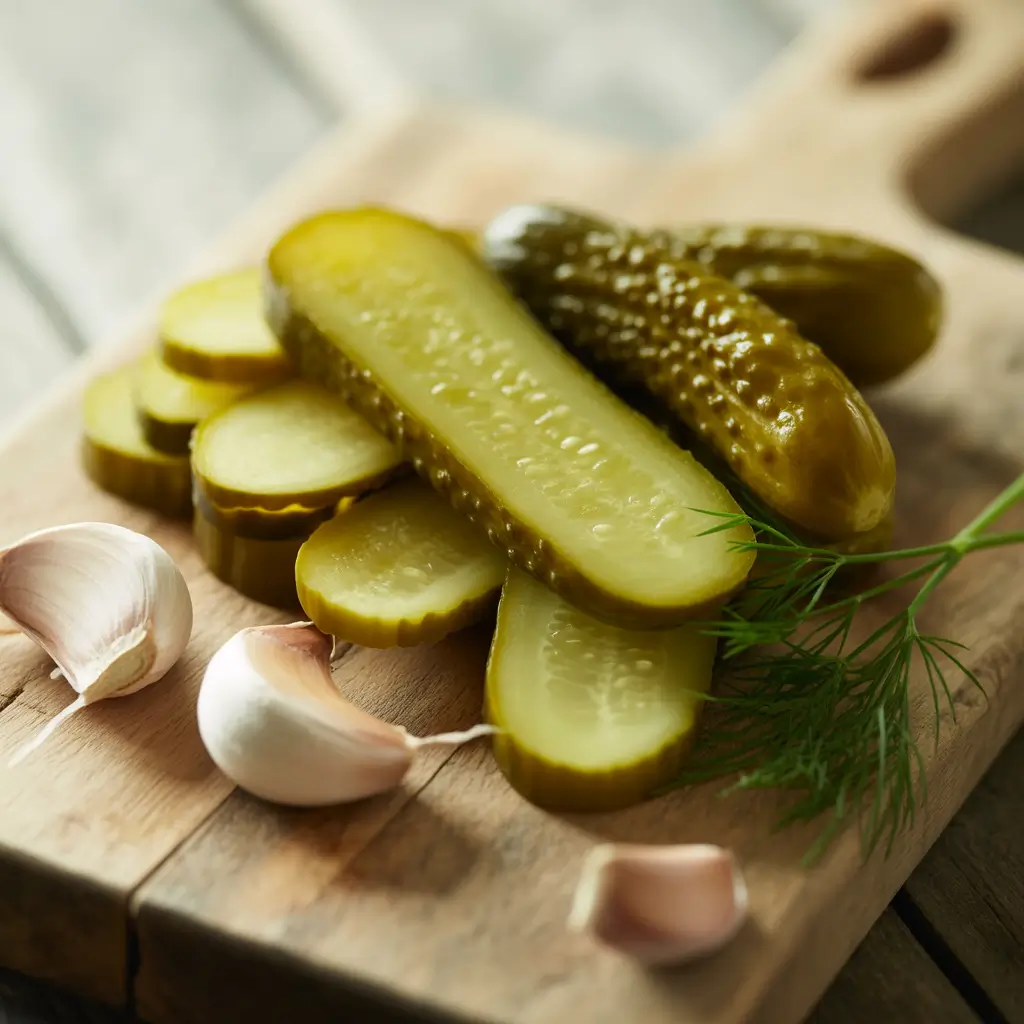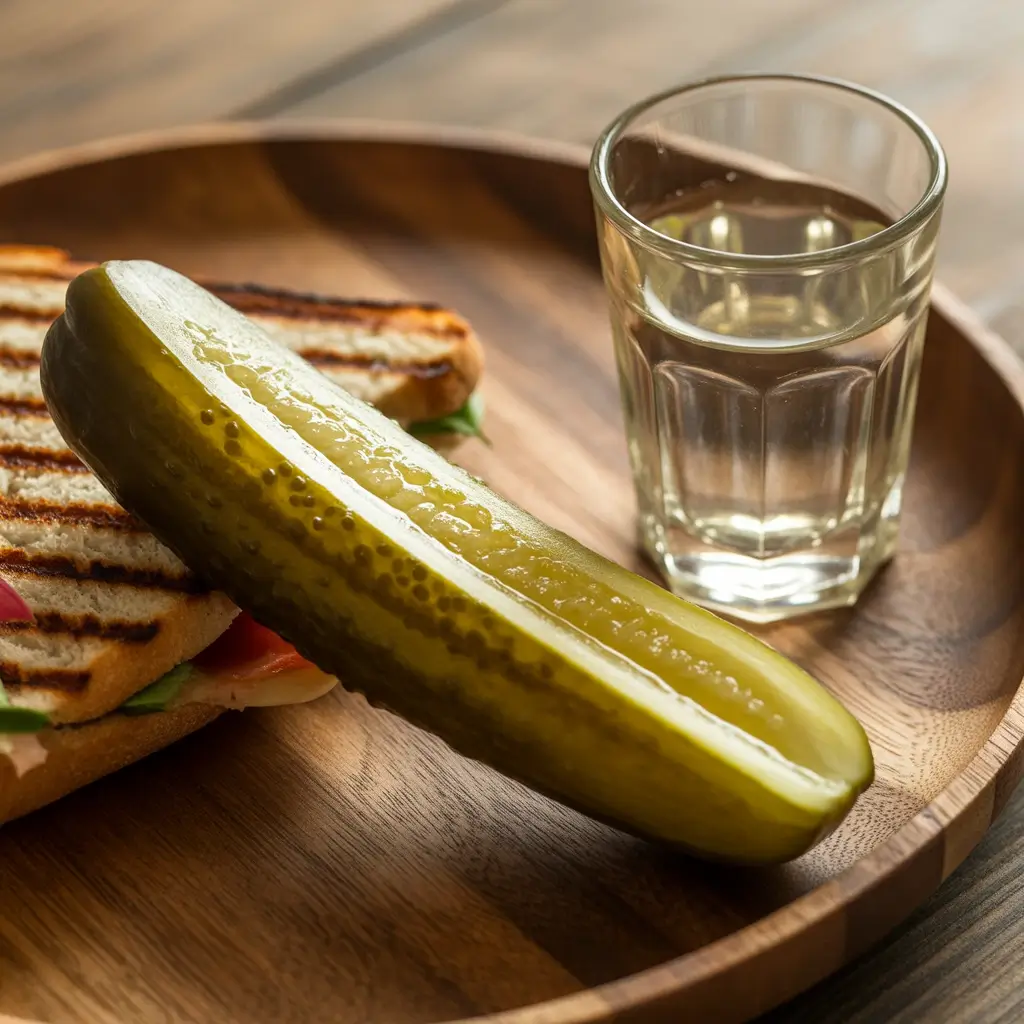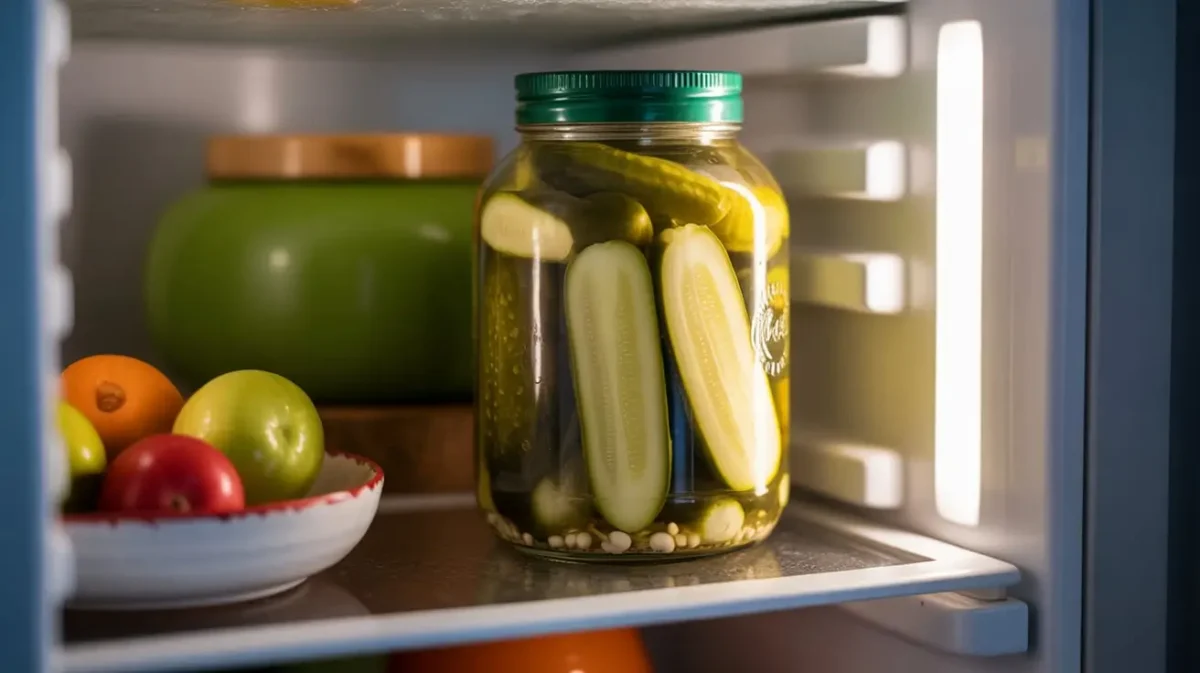introduction
The Cold Crunch America Can’t Get Enough Of
Claussen dill pickles are unlike any other jar on the shelf—or more accurately, in the fridge. Known for their bold flavor and signature crunch, these refrigerated pickles skip the heat to stay crisp and fresh. Since their creation in 1870, Claussen has redefined how America eats pickles, favoring cold-packing over pasteurization.
In this article, we explore what makes Claussen pickles so unique, including their ingredients, how they’re made, who owns the brand today, and whether they’re vegan. We’ll also dive into health benefits, tasty uses beyond sandwiches, and how Claussen compares to other popular pickle brands. Whether you’re a longtime fan or new to the cold crunch, you’ll find everything you need to know right here.
Looking for inspiration? Try our Top It Yogurt Shoppe guide for fresh flavors that match Claussen’s boldness.
table of contents
Table of Contents
Claussen Dill Pickles: The Cold Crunch America Can’t Get Enough Of
Everything you need to know about Claussen Dill Pickles—from their crisp cold-pack method to bold flavor, ingredients, health perks, and how they compare to other pickle brands.
- Prep Time: 5 minutes
- Cook Time: 0 minutes
- Total Time: 5 minutes
- Yield: Varies by jar size
- Category: Condiment
- Method: Cold Brined
- Cuisine: American
- Diet: Vegan
Ingredients
- Cucumbers
- Water
- Distilled vinegar
- Salt
- Garlic
- Dill
- Spices
- Mustard seed
- Calcium chloride (to maintain crunch)
- Natural flavors
- Polysorbate 80 (an emulsifier)
Instructions
- Claussen cucumbers are cold-packed with garlic, dill, and vinegar—never heat-pasteurized.
- They are kept refrigerated from production to sale, preserving crispness.
- To enjoy: eat straight from the jar, slice into sandwiches, or use in recipes.
- Ideas include pickle pizza, creamy pasta salad, pickle slaw, or deli wraps.
- Don’t toss the brine—use it for cocktails, marinades, or hangover relief.
Notes
Always store Claussen pickles in the refrigerator, sealed tightly. Do not leave them at room temperature.
The Origins of Claussen Dill Pickles
How Claussen Pickles Started in a Chicago Backyard
The roots of Claussen dill pickles trace back to 1870, when C.F. Claussen, a German immigrant, began pickling cucumbers grown in his Chicago garden. At a time when most pickles were heavily processed or canned, Claussen had a different idea—keep them fresh and crunchy. He started selling his homemade pickles to local delis and grocers, and the demand quickly took off.
What set Claussen apart from the beginning was his commitment to freshness. While other brands focused on long shelf life through pasteurization, Claussen relied on refrigeration to preserve the cucumbers’ natural snap. That bold move turned a small backyard project into one of America’s most recognizable pickle brands.
Refrigerated Pickles: A Game-Changer in the Pickling World
Claussen Dill Pickles is real innovation came from his decision to skip the heat entirely. By cold-packing cucumbers in a seasoned brine and keeping them refrigerated from production to store shelves, he created a new standard. Unlike shelf-stable pickles that lose their crunch in the heating process, Claussen pickles stayed crisp and vibrant in flavor.
This cold-chain model was rare in the early 20th century, but it paid off. Claussen’s pickles quickly gained a reputation for unmatched texture and taste, becoming a staple in American households. Even today, that cold crunch is what keeps fans coming back for more.
Discover great ideas like Yogurt Cream Top—another food trend built on freshness.
What Makes Claussen Dill Pickles So Different
Cold-Packed Perfection vs. Shelf-Stable Softness
One bite of Claussen dill pickles, and it’s clear—they’re in a different league. Unlike typical jarred pickles that sit on shelves for months, Claussen pickles are cold-packed and never heat-pasteurized. This one difference creates the unmistakable crunch that fans crave. While shelf-stable brands undergo high-heat processing that softens cucumbers, Claussen preserves the integrity of every spear by keeping them cool from the start.
The result? A pickle that snaps with each bite, maintaining the fresh taste of raw cucumbers while soaking up just the right amount of brine. It’s this refrigerated method that made Claussen a standout when it first hit stores—and still makes it hard to beat today.
The Science Behind the Claussen Dill Pickles
Why are Claussen Dill Pickles so crisp? It comes down to how cell walls react to heat. When cucumbers are cooked, their cell structure breaks down, leading to a mushier texture. Claussen avoids that completely. Their cold brining process locks in moisture while letting flavors like garlic, dill, and vinegar slowly seep into the vegetable.
This low-temperature method isn’t just a marketing angle—it’s rooted in food science. The preservation of texture through refrigeration has helped Claussen maintain its iconic bite, and that’s something pasteurized pickles simply can’t replicate.
Don’t miss our guide to Yogurt in a Bowl—another cool and crunchy food trend rising in popularity.
A Closer Look at Claussen Dill Pickles Ingredients

What’s Inside the Jar? A Simple Ingredient List with Big Flavor
At first glance, the ingredients in Claussen dill pickles look basic—but don’t be fooled. The power of these pickles comes from the balance between clean ingredients and smart preparation. Each jar typically includes:
- Cucumbers
- Water
- Distilled vinegar
- Salt
- Garlic
- Dill
- Spices
- Mustard seed
- Calcium chloride (to maintain crunch)
- Natural flavors
- Polysorbate 80 (an emulsifier)
The star, of course, is the cucumber—but it’s the supporting cast that builds Claussen’s signature flavor. The distilled vinegar and salt create a tangy, savory brine, while garlic and dill offer bold herbal notes that pop on the palate.
No Heat, No Artificial Preservatives—Just Freshness
What really sets Claussen apart is what’s not in the jar. Unlike shelf-stable pickles, Claussen avoids artificial preservatives and never uses heat during processing. Instead, cold brining allows the pickles to soak up flavor gradually while staying raw and crisp.
Additionally, calcium chloride plays a key role. It’s a natural firming agent that helps cucumbers retain their crunch without the need for pasteurization or additives. You won’t find high-fructose corn syrup or chemical preservatives here—just carefully chosen ingredients that let the cucumbers shine.
Looking for naturally preserved flavor? Try our Japanese Pink Salt Recipe, a mineral-packed option for homemade health boosters.
Who Owns Claussen Today?
From Homemade Pickles to a Global Brand
While Claussen dill pickles began as a family-run business in Chicago, their reputation quickly outgrew the backyard garden. Over the decades, increasing demand and national recognition led to major changes in ownership. By the 1970s, Claussen had become a powerhouse in the refrigerated pickle market—attracting the attention of major food corporations.
In 1970, Claussen was acquired by Oscar Mayer, which itself later became part of Kraft Foods. Today, Claussen is owned and distributed by The Kraft Heinz Company, one of the largest food and beverage companies in the world.
Despite being part of a corporate giant, Claussen’s production methods and core product line have remained largely unchanged. The brand has preserved its cold-packing process, ensuring that the pickles stay crisp and fresh—just as founder C.F. Claussen intended.
Modern Manufacturing, Classic Recipe
Claussen pickles are now produced in large-scale facilities using automated systems, but the cold-brining philosophy remains. The brand still requires refrigerated shipping and display, which is a logistical challenge most competitors avoid. That commitment to quality continues to distinguish Claussen from mainstream pickle producers.
Being part of Kraft Heinz has allowed Claussen to reach new markets without compromising its identity. It’s a rare example of a heritage recipe surviving corporate transition while staying true to its roots.
Don’t miss our look at handcrafted Italian classics like Ricotta Cheese and Spinach Ravioli, where tradition meets innovation.
Are Claussen Dill Pickles Vegan and Gluten-Free?
Claussen Dill Pickles and Vegan Diets
If you’re following a plant-based lifestyle, you’ll be happy to know that Claussen dill pickles are vegan-friendly. Their core ingredients—cucumbers, vinegar, water, garlic, dill, and spices—are all plant-based. No animal by-products, dairy, or gelatin are used in the brining process. Even the firming agent calcium chloride is a mineral compound, not derived from animals.
However, some strict vegans take issue with ambiguous ingredients like “natural flavors.” In Claussen’s case, Kraft Heinz has not specified whether those flavorings are 100% plant-derived. Still, there are no known animal-based ingredients listed, and most vegan communities consider Claussen pickles safe to eat.
Are Claussen Pickles Gluten-Free? Yes—But Always Check
Yes, Claussen pickles are generally considered gluten-free. None of the ingredients in the standard dill pickle recipe include wheat, rye, barley, or their derivatives. This makes them a great snack or sandwich addition for those with gluten sensitivities or celiac disease.
However, cross-contamination is always a possibility in large-scale food manufacturing. Kraft Heinz has not certified Claussen pickles as “gluten-free,” but they are made without gluten-containing ingredients.
If you’re extremely sensitive, it’s wise to read the label or contact the manufacturer directly for the most current information.
Looking for clean-eating trends? Our Japanese Pink Salt Recipe is another naturally gluten-free kitchen staple worth exploring.
Health Benefits of Claussen Dill Pickles
Pickles and Gut Health: Are Claussen Pickles Probiotic?
One of the biggest draws of pickled foods today is their potential gut health benefits—especially when they contain live cultures. While Claussen dill pickles are cold-packed and never heat-pasteurized, they are not classified as probiotic. That’s because Claussen pickles are made with vinegar, not through traditional lactic acid fermentation, which is what promotes active probiotic cultures.
Still, their refrigerated nature means Claussen pickles maintain more of their natural enzymes than shelf-stable brands. While not a true probiotic source, they can support digestion thanks to their vinegar content, which helps increase stomach acidity and enzyme activity.
Sodium, Vinegar, and Flavor: Pros and Cons of the Crunch
There are a few nutritional upsides to Claussen dill pickles. They are:
- Low in calories (usually 5–10 per spear)
- Fat-free and cholesterol-free
- Made with natural herbs and spices
But the downside? Sodium. A single spear can have over 300 mg of sodium, which adds up fast if you snack on them regularly. For people managing blood pressure or sodium-restricted diets, moderation is key.
The vinegar in Claussen pickles may also help with blood sugar control and appetite regulation, though more studies are needed.
So while Claussen pickles aren’t a superfood, they can still be a crunchy, flavorful part of a balanced diet—just don’t eat the whole jar in one sitting.
Looking for lighter food swaps? Discover Yogurt in a Bowl, a protein-packed option that pairs well with salty snacks like pickles.
How to Use Claussen Pickles Beyond Sandwiches

Unexpected Recipes Featuring Claussen Dill Pickles
Claussen dill pickles aren’t just a sidekick for burgers—they can be the star of bold, flavorful dishes. Thanks to their crisp texture and tangy punch, these pickles shine in all kinds of creative recipes. Here are some tasty ways to use them:
- Pickle Pizza: Top your cheese pizza with thinly sliced Claussen pickles and a drizzle of ranch dressing. The crisp texture and tangy bite perfectly complement the smooth richness of the cheese.
- Claussen spear pickles: finely chopped, bring a zesty punch to a creamy pasta salad tossed with celery slices, cheddar chunks, and vibrant red onion.. It’s a flavor bomb.
- Pickle Slaw: Add chopped pickles to coleslaw for a vinegary twist. It pairs great with BBQ or fried chicken.
- Pickle Wraps: Spread cream cheese on deli meat, roll it around a Claussen spear, and slice for an easy, high-protein snack.
These ideas are perfect for pickle lovers looking to branch out beyond basic bites.
Surprising Uses for Leftover Pickle Juice
Don’t toss that leftover brine. Claussen pickle juice has many unexpected uses:
- Cocktails: Add it to Bloody Marys or take a “pickleback” shot with whiskey.
- Marinades: Use the juice to tenderize chicken or pork with a zesty, garlicky flavor.
- Hangover Relief: Some people swear by pickle juice as a natural remedy for dehydration and cramping.
Even your plants may love it—diluted pickle juice can help deter garden pests.
Check out Top It Yogurt Shoppe for more quirky food pairings that go beyond the norm.Looking for creative Claussen recipes? Explore our curated Pinterest boards packed with food inspiration.
Claussen Pickles vs. Other Brands
Claussen vs. Vlasic, Mt. Olive, and Grillo’s
When it comes to store-bought pickles, Claussen dill pickles often go head-to-head with brands like Vlasic, Mt. Olive, and Grillo’s Pickles. But not all pickles are created—or processed—the same.
Here’s a quick breakdown:
| Brand | Refrigerated? | Pasteurized? | Known For |
|---|---|---|---|
| Claussen | Yes | No | Cold-packed crunch, bold garlic |
| Vlasic | No | Yes | Shelf-stable, mass distribution |
| Mt. Olive | No | Yes | Southern-style sweet/sour pickles |
| Grillo’s | Yes | No | Fresh herbs, small-batch appeal |
Claussen and Grillo’s are both refrigerated and unpasteurized, which helps maintain their crisp texture and bold flavor. However, Claussen has a more classic dill flavor profile with garlic, while Grillo’s leans into artisanal herbs like fresh dill and grape leaves.
Vlasic and Mt. Olive dominate the shelf-stable market. They’re more accessible and last longer without refrigeration, but they tend to be softer due to heat processing.
Taste and Texture: Who Wins the Crunch War?
If crunch is your priority, Claussen consistently comes out on top in blind taste tests. The cold-brining process preserves the snap, whereas shelf-stable pickles often feel mushy or overly sweet.
Flavor-wise, Claussen offers a punchy garlic-forward taste that balances vinegar and salt, while brands like Mt. Olive might skew sweeter, and Vlasic goes for mass-market neutrality.
So, if you’re after that signature crisp bite and tangy balance, Claussen dill pickles remain a top contender.
Looking for classic-meets-trendy flavor battles? Explore Yogurt in a Bowl for another take on food that blends heritage with freshness.
Where to Buy Claussen Dill Pickles in the USA
National Retailers That Stock Claussen
Unlike most pickles on the shelf, Claussen dill pickles are refrigerated—so you won’t find them in the canned goods aisle. Instead, look in the refrigerated deli section of most major grocery chains. Popular retailers that typically carry Claussen include:
- Walmart
- Kroger
- Safeway
- Publix
- Albertsons
- Costco
- Target
Because Claussen relies on a cold supply chain, availability may vary by region, especially in smaller or rural markets. Always check the deli fridge near packaged meats and cheeses.
Online Options for Delivery
If you’re looking to buy Claussen pickles online, your best options are:
- Walmart.com
- Instacart (from local stores)
- Amazon Fresh (in select regions)
- Target Pickup/Delivery
Due to refrigeration requirements, Claussen may not be eligible for long-distance shipping unless the retailer uses a temperature-controlled service. Here’s a 100% unique rewrite of that section:
Before You Order:
Double-check delivery guidelines to make sure your pickles arrive fresh and chilled.
How to Store Them – Stay Crisp, Stay Cool
2. Always store Claussen pickles in the refrigerator—even when the jar is still sealed—to maintain their signature crunch and flavor. Once opened, tightly seal the jar and keep it near the back of your fridge, where the temperature is coldest.
Never leave the jar out at room temperature, or the pickles may lose their crunch—or worse, spoil. With proper storage, Claussen pickles stay crisp and tasty for weeks after opening.
Don’t miss our refreshing summer pick: Cucumber Lemonade with Mint—a perfect pairing for salty snacks like pickles.
requently Asked Questions About Claussen Dill Pickles
What is the story behind Claussen pickles?
Claussen pickles began in 1870 when C.F. Claussen started selling cold-packed cucumbers from his Chicago garden. Unlike traditional pickles, his were refrigerated—not cooked—preserving crunch and flavor. That method made Claussen a national favorite.
What are the ingredients in Claussen pickles?
Claussen pickles contain cucumbers, water, distilled vinegar, salt, garlic, dill, spices, calcium chloride (for crunch), and polysorbate 80 (an emulsifier). They’re cold-packed, with no artificial preservatives.
Who makes Claussen dill pickles?
Claussen is now owned by The Kraft Heinz Company. Though no longer family-run, the pickles still follow their original refrigerated, non-pasteurized process.
Are Claussen pickles vegan?
Yes. Claussen pickles are vegan-friendly and made without animal products. While “natural flavors” are unspecified, they’re generally safe for plant-based diets.
Conclusion: The Crunch That Claussen Dill Pickles Own
Claussen dill pickles stand out for one reason: cold-packed crunch you can taste. With fresh ingredients and no heat processing, they deliver bold flavor in every bite.
If you’re craving a crisp, no-compromise pickle, Claussen is the go-to. Just remember—look in the fridge, not the shelf.
Don’t miss our Top It Yogurt Shoppe flavor guide for another cool trend worth trying.
Follow our food adventures and updates on Facebook to stay in the flavor loop.


